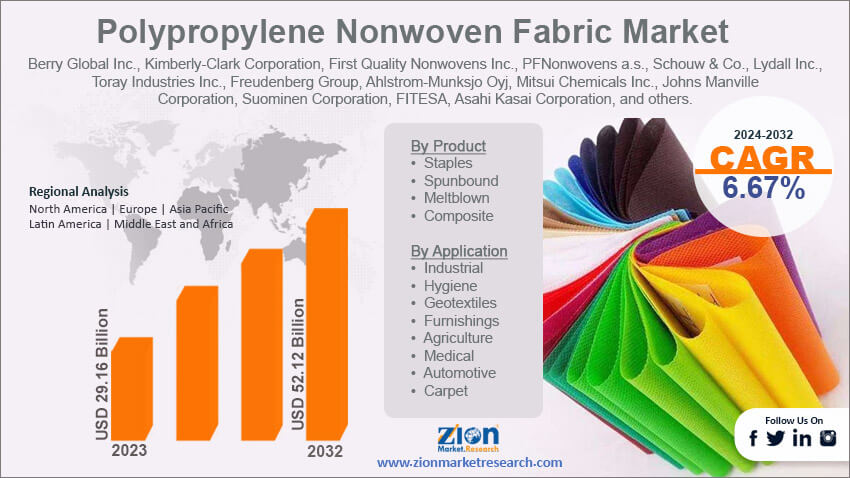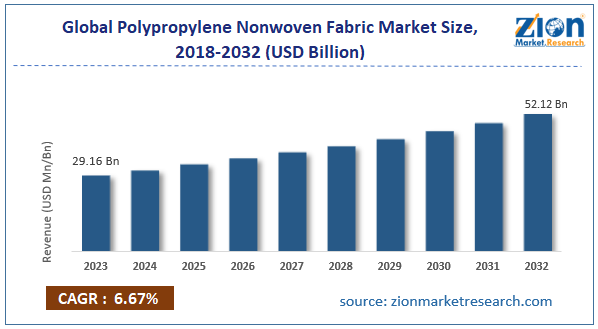Polypropylene Nonwoven Fabric Market Size, Share, Growth, Trends, and Forecast, 2030

Polypropylene Nonwoven Fabric Market By Product (Staples, Spunbound, Meltblown and Composite), By Application (Industrial, Hygiene, Geotextiles, Furnishings, Agriculture, Medical, Automotive, Carpet and Others) and By Region - Global and Regional Industry Overview, Market Intelligence, Comprehensive Analysis, Historical Data, and Forecasts 2024 - 2032
| Market Size in 2023 | Market Forecast in 2032 | CAGR (in %) | Base Year |
|---|---|---|---|
| USD 29.16 Billion | USD 52.12 Billion | 6.67% | 2023 |
Polypropylene Nonwoven Fabric Industry Perspective:
The global polypropylene nonwoven fabric market size was worth around USD 29.16 billion in 2023 and is predicted to grow to around USD 52.12 billion by 2032 with a compound annual growth rate (CAGR) of roughly 6.67% between 2024 and 2032.
Polypropylene Nonwoven Fabric Market: Overview
One of the thermoplastic polymers used in many sectors, such as electronics, apparel, and medicine, is polypropylene (PP) nonwoven fabric. It is made from propylene monomer using chain-growth polymerization. Polypropylene is a polyolefin (non-polar, partly crystalline) compound. Regarding characteristics, it is comparable to polyethylene, although it is somewhat more resilient and heat-resistant. The material is white and resistant to both chemicals and mechanical forces. All of its fibers are short and continuous, and they have undergone thermal, mechanical, chemical, or solvent treatments.
A nonwoven fabric is a material that resembles cloth. As used in the textile industry, the phrase refers to fabrics that are neither woven nor knitted. The polypropylene nonwoven fabric market is being driven by several factors including growing demand for hygiene products, rising healthcare industry, growing environmental concerns, growth in the automotive sector, technological advancements, expansion of the construction sector and many others.
Key Insights
- As per the analysis shared by our research analyst, the global Polypropylene Nonwoven Fabric market is estimated to grow annually at a CAGR of around 6.67% over the forecast period (2024-2032).
- In terms of revenue, the global Polypropylene Nonwoven Fabric market size was valued at around USD 29.16 billion in 2023 and is projected to reach USD 52.12 billion, by 2032.
- The growing demand from various end-use industries is expected to propel the market growth during the forecast period.
- Based on the product, the Spunbound segment is expected to hold a substantial market share over the forecast period.
- Based on the application, the hygiene segment is expected to capture the largest market share over the forecast period.
- Based on region, the Asia Pacific is expected to dominate the market over the forecast period.
 Request Free Sample
Request Free Sample
Polypropylene Nonwoven Fabric Market: Growth Drivers
Growing need for personal hygiene products drives market growth
Nonwoven fabrics have a long history of use in a variety of healthcare products. Because of their low production costs, versatility in incorporating various mechanical properties, and ease of disposal—all of which reduce cross-infection and enable the maintenance of high hygiene standards—they have made significant advancements in the hygiene product industry.
Several synthetic ingredients, including metal dyes that trigger allergies and eventually lead to cancer, are included in traditional napkins. Women are more inclined to utilize polypropylene nonwoven goods like sanitary pads and napkins because of an increased understanding of these negative impacts. Businesses in the market for such goods are creating feminine hygiene products by taking cues from changing customer behavior.
Polypropylene Nonwoven Fabric Market: Restraints
Vulnerable to UV degradation hindering the market growth
Despite polypropylene's many benefits—such as its low coefficient of friction, flexural strength, chemical resistance, and affordability—it is susceptible to UV deterioration. Polypropylene's polymer structure is a simple chain and heat and sunlight tend to disrupt this link.
Due to their extensive exposure to heat and severe environments, polypropylene geotextiles are widely employed in road building operations, however, because of their superior fatigue resistance, UV degradation is expected to hinder their demand. Thus, this is expected to hamper the market growth over the forecast period.
Polypropylene Nonwoven Fabric Market: Opportunities
Growing demand for geotextiles offers an attractive opportunity for market growth
With synthetic and permeable materials, geotextiles are mainly employed in civil construction projects to enhance the quality of soil. Poor soils become more suitable for building when they are separated, filtered, strengthened, protected, and drained with geotextiles. Geotextiles are advantageous in infrastructure projects such as building highways, ports, landfills, drainage systems, and more. Worldwide, the need for nonwoven geotextiles has surged because of the accelerated building activity in emerging nations.
Nonwoven geotextiles are more environmentally friendly and less expensive to ship than gravel when used in buildings because of their lightweight nature. They have benefits for building retaining walls, foundations, and erosion prevention as well. Nonwoven geotextile demand is anticipated to rise in response to the growing need for affordable, long-lasting building materials, ultimately propelling the expansion of polypropylene nonwoven fabric.
Polypropylene Nonwoven Fabric Market: Challenges
The availability of alternatives poses a major challenge to market expansion
Alternative materials including cotton, polyester, and biodegradable fibers are competitors in the nonwoven fabric business. These materials could be more advantageous in terms of comfort, biodegradability, or functionality in particular applications. Manufacturers of polypropylene nonwoven fabric must innovate and set themselves apart from the competition by providing special features and catering to niche markets to preserve market share and competitiveness. Thus, the availability of alternatives poses a major challenge to the market expansion.
Polypropylene Nonwoven Fabric Market: Segmentation
The global polypropylene nonwoven fabric industry is segmented based on Product, Application and region.
Based on the product, the global Polypropylene Nonwoven Fabric market is bifurcated into Staples, Spunbound, Meltblown and Composite. The Spunbound segment is expected to hold a substantial market share over the forecast period because it is the most straightforward and economical method of producing nonwoven polypropylene textiles. Spunbonded nonwoven textiles' superior qualities and the technology's great production efficiency are expected to fuel demand for the product across a range of applications. Geotextiles, hygiene, medicine, packaging, and shoe manufacture are a few of these uses. The most popular technique for producing nonwoven textiles is spunbonding. Thereby, driving the segment expansion.
Based on the application, the global Polypropylene Nonwoven Fabric industry is segmented into Industrial, Hygiene, Geotextiles, Furnishings, Agriculture, Medical, Automotive, Carpet and Others. The hygiene segment is expected to capture the largest market share over the forecast period. When compared to traditional textiles, nonwoven fabric materials offer superior smoothness, softness, comfort, stretchability, fluid-barring capacity, and absorption. Consequently, there is a growing market for hygiene product manufacture. By absorbing and holding onto urinating, these products aid in keeping fences within the fabric and separate moisture from the skin. Unlike typical textiles, these items have no smell and provide exceptional smoothness, which is why they are expected to be in great demand over the coming years. Throughout the projection period, the demand for adult incontinence products is expected to be driven by the growing elderly population, which is contributing to the rise in the prevalence of chronic disorders like diabetes. Hence favorably affecting the market for nonwoven polypropylene fabrics.
Polypropylene Nonwoven Fabric Market: Report Scope
| Report Attributes | Report Details |
|---|---|
| Report Name | Polypropylene Nonwoven Fabric Market |
| Market Size in 2023 | USD 29.16 Billion |
| Market Forecast in 2032 | USD 52.12 Billion |
| Growth Rate | CAGR of 6.67% |
| Number of Pages | 223 |
| Key Companies Covered | Berry Global Inc., Kimberly-Clark Corporation, First Quality Nonwovens Inc., PFNonwovens a.s., Schouw & Co., Lydall Inc., Toray Industries Inc., Freudenberg Group, Ahlstrom-Munksjo Oyj, Mitsui Chemicals Inc., Johns Manville Corporation, Suominen Corporation, FITESA, Asahi Kasai Corporation, and others. |
| Segments Covered | By Product, By Application, and By Region |
| Regions Covered | North America, Europe, Asia Pacific (APAC), Latin America, Middle East, and Africa (MEA) |
| Base Year | 2023 |
| Historical Year | 2018 to 2022 |
| Forecast Year | 2024 - 2032 |
| Customization Scope | Avail customized purchase options to meet your exact research needs. Request For Customization |
Regional Analysis
The Asia Pacific is expected to dominate the market over the projected period
The Asia Pacific is expected to dominate the market over the forecast period. The higher percentage is associated with China, the world's largest manufacturer, producing PP nonwoven fabric in massive quantities. In China's metropolitan centers, the use of disposable newborn diapers is rising. According to one survey, over 70% of moms used baby diapers twice a day regularly to keep their children clean. The PP nonwoven fabric market in the region is growing as a result of India's enhanced production capacity to meet the growing demand for face masks and sanitary napkins.
In addition, the Indian government has started several programs to encourage women to use sanitary pads and napkins to avoid getting urinary tract infections. Thus, this is expected to drive the market growth in the region.
Polypropylene Nonwoven Fabric Market: Competitive Analysis
The global Polypropylene Nonwoven Fabric market is dominated by players like:
- Berry Global Inc.
- Kimberly-Clark Corporation
- First Quality Nonwovens Inc.
- PFNonwovens a.s.
- Schouw & Co.
- Lydall Inc.
- Toray Industries Inc.
- Freudenberg Group
- Ahlstrom-Munksjo Oyj
- Mitsui Chemicals Inc.
- Johns Manville Corporation
- Suominen Corporation
- FITESA
- Asahi Kasai Corporation.
The Global Polypropylene Nonwoven Fabric market is segmented as follows:
By Product
- Staples
- Spunbound
- Meltblown
- Composite
By Application
- Industrial
- Hygiene
- Geotextiles
- Furnishings
- Agriculture
- Medical
- Automotive
- Carpet
- Others
By Region
- North America
- The U.S.
- Canada
- Europe
- France
- The UK
- Spain
- Germany
- Italy
- Rest of Europe
- Asia Pacific
- China
- Japan
- India
- South Korea
- Southeast Asia
- Rest of Asia Pacific
- Latin America
- Brazil
- Mexico
- Rest of Latin America
- Middle East & Africa
- GCC
- South Africa
- Rest of Middle East & Africa
Table Of Content
Methodology
FrequentlyAsked Questions
One of the thermoplastic polymers used in many sectors, such as electronics, apparel, and medicine, is polypropylene (PP) nonwoven fabric. It is made from propylene monomer using chain-growth polymerization. Polypropylene is a polyolefin (non-polar, partly crystalline) compound. Regarding characteristics, it is comparable to polyethylene, although it is somewhat more resilient and heat-resistant. The material is white and resistant to both chemicals and mechanical forces.
The polypropylene nonwoven fabric market is being driven by several factors including growing demand for hygiene products, rising healthcare industry, growing environmental concerns, growth in the automotive sector, technological advancements, expansion of the construction sector and many others.
According to the report, the global market size was worth around USD 29.16 billion in 2023 and is predicted to grow to around USD 52.12 billion by 2032.
The global Polypropylene Nonwoven Fabric market is expected to grow at a CAGR of 6.67% during the forecast period.
The global Polypropylene Nonwoven Fabric market growth is expected to be driven by the Asia Pacific. It is currently the world’s highest revenue-generating market due to the growing automotive industry.
The global Polypropylene Nonwoven Fabric market is dominated by players like Berry Global, Inc., Kimberly-Clark Corporation, First Quality Nonwovens Inc., PFNonwovens a.s., Schouw & Co., Lydall, Inc., Toray Industries Inc., Freudenberg Group, Ahlstrom-Munksjo Oyj, Mitsui Chemicals Inc., Johns Manville Corporation, Suominen Corporation, FITESA and Asahi Kasai Corporation among others.
The Polypropylene Nonwoven Fabric Market report covers the geographical market along with a comprehensive competitive landscape analysis. It also includes cash flow analysis, profit ratio analysis, market basket analysis, market attractiveness analysis, sentiment analysis, PESTLE analysis, trend analysis, SWOT analysis, trade area analysis, demand & supply analysis, Porter’s five forces analysis, and value chain analysis.
HappyClients
Zion Market Research
Tel: +1 (302) 444-0166
USA/Canada Toll Free No.+1 (855) 465-4651
3rd Floor,
Mrunal Paradise, Opp Maharaja Hotel,
Pimple Gurav, Pune 411061,
Maharashtra, India
Phone No +91 7768 006 007, +91 7768 006 008
US OFFICE NO +1 (302) 444-0166
US/CAN TOLL FREE +1 (855) 465-4651
Email: sales@zionmarketresearch.com
We have secured system to process your transaction.
Our support available to help you 24 hours a day, five days a week.
Monday - Friday: 9AM - 6PM
Saturday - Sunday: Closed





